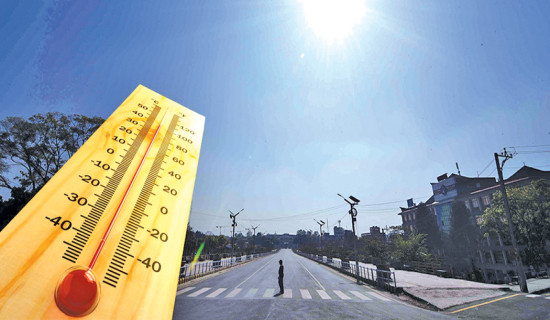- Tuesday, 23 December 2025
Need To Ensure Disaster Resilience
The monsoon season has arrived in Nepal. As soon as it arrived in eastern Nepal in the second week of June, it started playing havoc, damaging houses, farmlands and bridges in Sankhuwasabha by inducing rain, floods and landslides. Since then, other districts have also been in the grip of the monsoons. The Department of Hydrology and Meteorology (DoHM) has forecast above-normal rain and above-average maximum and minimum temperatures this monsoon season. This could lead to extreme weather patterns. Evidence shows that maximum temperatures in Nepal are rising fast with an annual increment of 0.056 Degrees Celsius as against the global average increase of 0.03 degrees Celsius. According to experts, extreme weather is frequent.
Extreme weather patterns include excessive rain in a short period of time, incessant rain for several days after the monsoon season, dry spells and droughts, below-average precipitation and above-normal temperatures. The department has forecast weather for four months from June to September. As per the forecast, most parts of Nepal are likely to experience above-average maximum and minimum temperatures and above-normal rain. Nepal has experienced extreme weather many times for over a decade. Climate change is also to blame for the persistence of extreme weather.
Measures
On the one hand, the monsoon season is salubrious for agricultural activities, while on the other it wreaks havoc by inducing natural disasters such as floods and landslides. The monsoons affect life and property every year. We cannot completely stop the devastation caused by the monsoons; however, measures can be taken to mitigate their effects. Nepal has enacted a legal mechanism, the Disaster Risk Reduction and Management Act, 2017. The Act recognises earthquakes, fires, storms, floods, landslides, heavy rain, droughts, famines and epidemics as disasters. It intends to protect life, public and private property and national and cultural heritages, and minimise risks. It mandates the formation of a national council, executive committee and authority and assigns roles, responsibilities and accountability to the agencies concerned for disaster management.
The law also requires deploying the security personnel during disasters and the management of skilled manpower and sophisticated equipment to fight disasters with the clear-cut assignment of duties to the Nepal Police, Armed Police Force and Nepali Army. Security agencies play a crucial role in disaster management such as rescue, resettlement and distribution of relief materials. The National Disaster Risk Reduction and Management Authority (NDRRMA) has been provided with greater power by the said Act. The Authority is crucial to facilitating coordination and collaboration with all the agencies concerned for disaster management.
The NDRRMA, however, faces several hassles. It has to depend on the Ministry of Home Affairs for cabinet decisions, the control over security mobilisation during humanitarian crises and the mobilisation of foreign aid. Nepal has three tiers of government. The country has a disaster management mechanism involving all these tiers of government. In accordance with the Local Government Operation Act, 2017, local governments work directly with local communities for disaster mitigation, rescue, relief, resettlement and rehabilitation. The Act mandates the establishment of disaster management funds and the mobilisation of resources essential for disaster management. In fact, the local governments and communities are the first responders to disasters.
The Constitution of Nepal mandates that disaster resilience be ensured by developing a coordination mechanism between the government and disaster management agencies. Disaster management laws are designed to support cooperation among the government, domestic entities and international entities and also to ensure inter-governmental collaboration at all levels of government. The government has integrated the core principles of the Sendai Framework for Disaster Risk Reduction into the National Disaster Risk Reduction Strategic Action Plan (2015-2030). There are several departments under different ministries to enhance the capacity for response, preparedness and risk reduction. Nepal has adopted a national plan of action on disaster management, focusing on disaster preparedness, response, reconstruction and rehabilitation, and mitigation.
The establishment of a disaster management mechanism involving all the levels of government, local communities and security agencies is laudable, but there are challenges of effectively managing disasters. The first responders (the local governments and communities) lack required manpower and resources to tackle disasters. It is a no-brainer that saving life and property is essential during disasters. There are also challenges associated with rescue, relief and rehabilitation. Hundreds of people may be displaced during disasters. They often have to cope with managing food, clothing and shelter.
Bottom-up approach
Moreover, health issue may crop up after disasters. Diseases such as diarrhoea, dysentery and gastroenteritis may affect disaster victims. To cope with such a situation, the government should also keep medical teams on standby. The government should accord top priority to disaster management. The government has adopted a bottom-up approach whereby the local governments act as first responders in collaboration with local communities. To make disaster management effective at the local level, the local governments should be equipped with skilled manpower and adequate resources. For this, training should be periodically imparted to the employees of the local governments as well as to the members of local communities.
The government should not be stingy with allocating sufficient budgets for such training and resource management. Without adequate budgets and skilled manpower, disasters cannot be effectively managed. There are a few academic institutions that offer courses on disaster management in Nepal. The National Plan for Disaster Risk Reduction has the provision of setting up a Disaster Risk Reduction Research and Training Institute. There is an acute need for establishing such an institute. Such an institute aims at enhancing research and capacity development for disaster risk reduction, prevention, preparedness, search and rescue, post-disaster recovery, rehabilitation and reconstruction. It would also be prudent on the part of the government to introduce courses on disaster management in schools and colleges as well.
(Maharjan has been regularly writing on contemporary issues for this daily since 2000.)

















